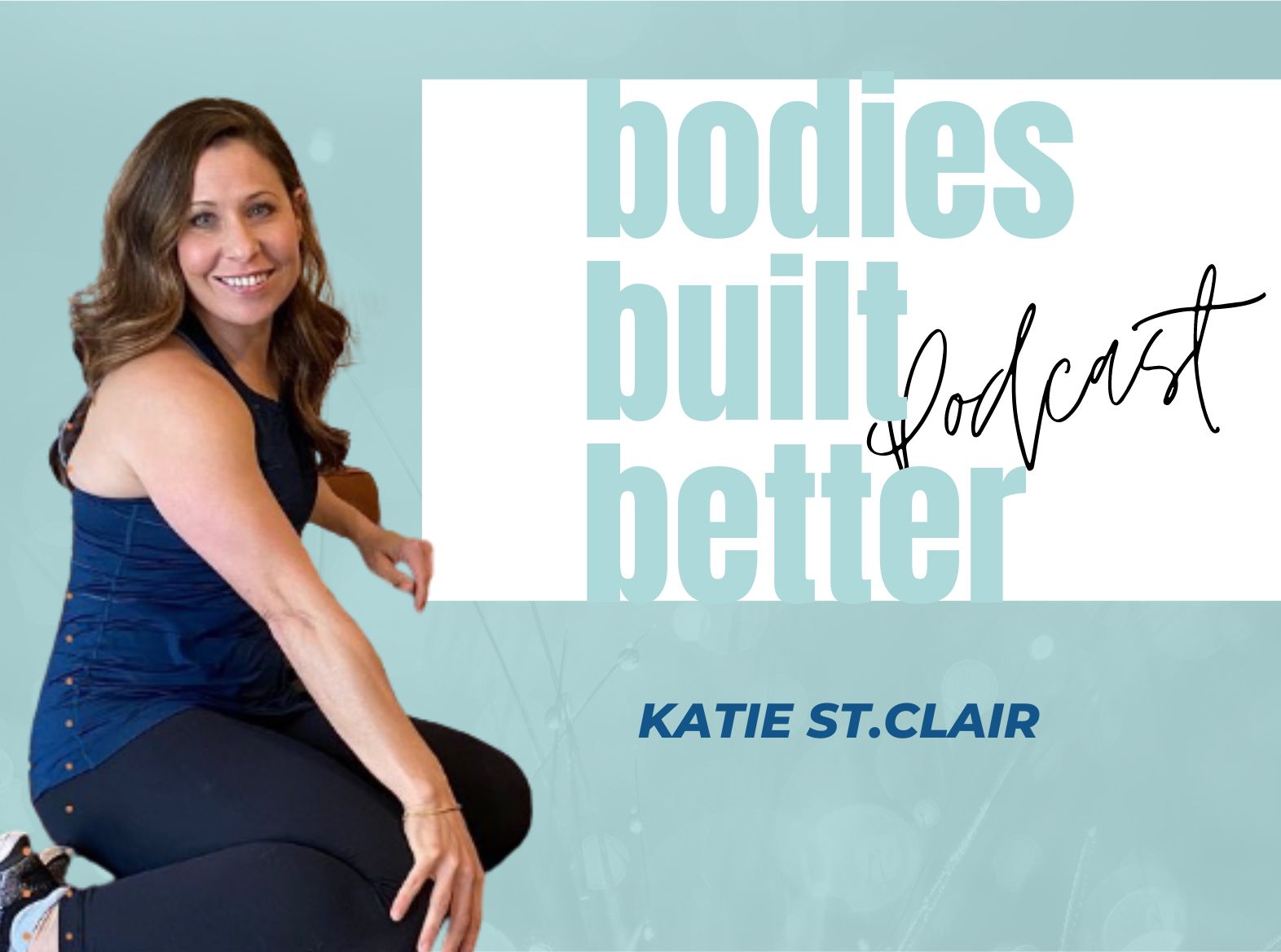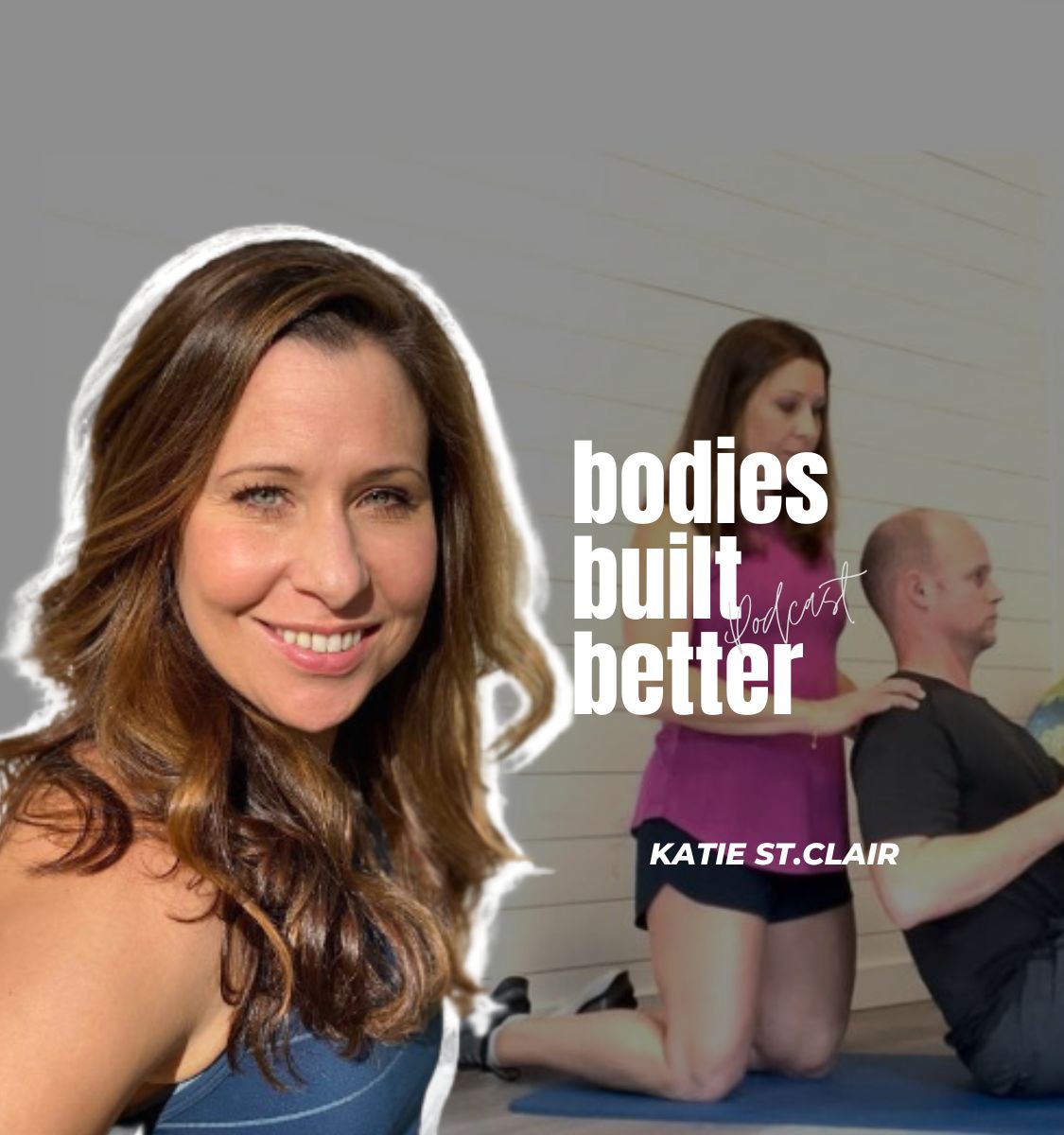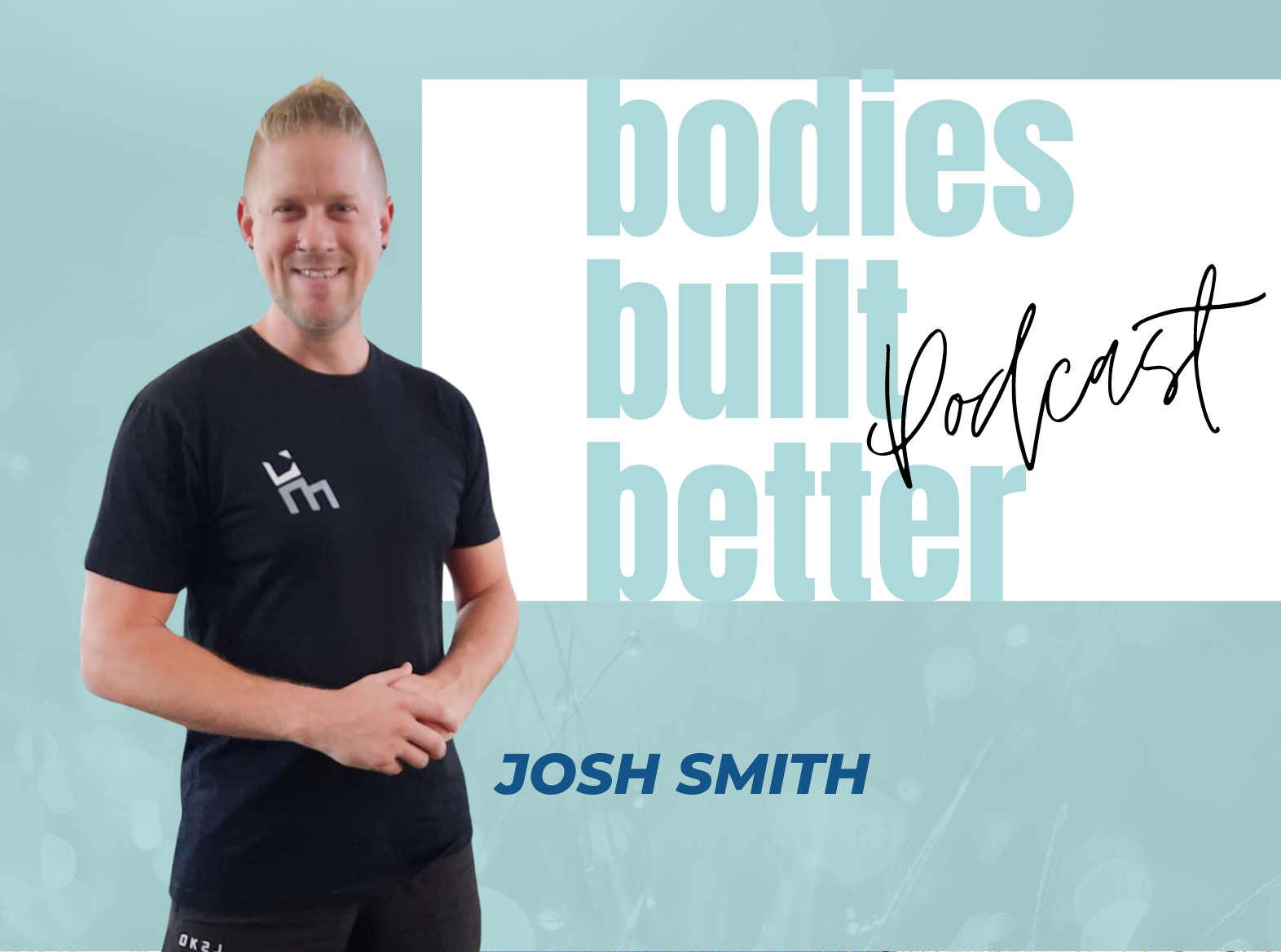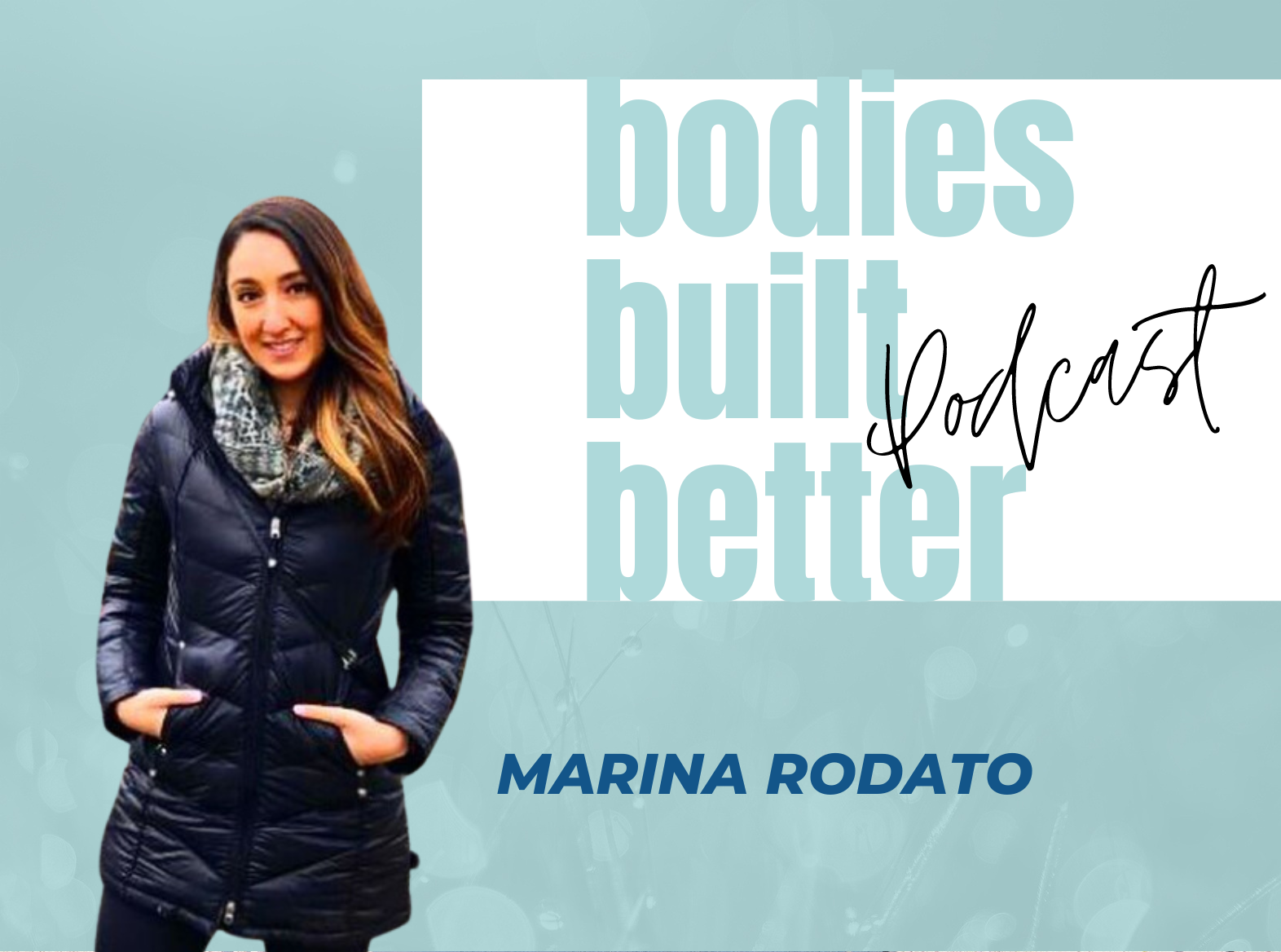Finding The Right Solution: How To Evolve Your Training
Jackie 3:00
Katie, thank you so much for chatting with me today. Welcome to the Bodies Built Better podcast.
Katie 3:05
Thank you so much. I’m super excited to talk to you and talk about all things breathing movement, everything your audience hopefully wants to hear about.
Jackie 3:14
Yeah, they absolutely do. And the thing that I love about you, and that I feel–I’ve Well, firstly, yeah, I feel like there’s not a lot of the content that you provide out there. I follow a lot of trainers, and it’s, it’s all about strength training. And I truly believe every single person on the planet should be strength training. But I feel like a lot of people, also training in pain. And I feel like this is the missing golden puzzle piece that they need to hear about or be aware of anyway, so I’m really excited to chat with you today. Before we get into that, I’d love for you to give the listeners a little bit of background on you, how you got into the industry, and then how you evolved into the training you are today.
Katie 4:01
Sure, sure. So I won’t go back all the way because I’ve been doing this for 23 years. So that would be a lot to sift through. But I’ll say that generally, I always had a passion for movement. I was a young athlete as a gymnast, so pretty serious in that sport from a young age. And I knew that movement really influenced my, not just my physical but my emotional health. And sort of along the way, I ended up with my own set of injuries, what you hear from a lot of ex-athletes and people who end up as movement professionals because we’re trying to fix our own stuff. And we are coming across systems and things that just don’t work or maybe just aren’t the right fit for what we need. And so, for me, it became a lot of troubleshooting and just figuring out what my own body needs, but what I really ended up happening is, I started my own business probably 15 years ago serving mostly Gen Pop, um, younger athletes like high school age, I had done the college athletic thing, you know, years before that. But what I realised is that most people that started coming to me were coming to me because they had been injured or they were injured. And the only reason they were coming to me is, I was in my mind, at the time, is,that I was good at not causing an injury, but I really didn’t have the foundational knowledge to understand how I might actually be able to help them. And while I don’t treat pain, and I don’t diagnose, we know, as trainers, that people come to you with pain, and you have to be able to work around that, and at the very least, have a trainable menu for them. And so I became good at that. But deep down, I was going, but why, but why, like, I need to know so that I can programme effectively, so that I’m doing more than just finding a trainable menu. And I’m actually finding things that are improving their movement options. So they don’t have to live in that small window of options that they have at the current time. And that sort of led me down kind of just a road of discovery, both through my own journey with my injuries, and then also just seeking to do better as a trainer for my clients.
The Importance Of Active Participation in Physical Therapy
Jackie 6:23
Yeah. And with the knowledge that you have now, thinking back, those times you were injured, do you go off? Or only did this? Or how would I do that differently?
Katie 6:37
Oh, yeah, I mean…
Jackie 6:40
Too much?
Katie 6:41
No, it’s just so much to think about, because at the time, my husband was actually in physical therapy school. And so I’ve had access to some of the best physical therapy–therapists in the area at the university level. In clinics, you know, I could pretty much get in with anybody I wanted to, and they weren’t helping me. And I think I felt sort of defeated inside because there wasn’t active participation. It was a lot of passive treatment modalities, them fixing me and me leaving and going, Well, I feel like I’m, I need to see this person everyday just to feel normal. And that doesn’t make sense. Absolutely. No one is going to have access to somebody to work on them every single day. And even if they do, the body needs you to be an active participant in order to heal. And so, yeah, it’s interesting now, looking back, I don’t think there was one thing I needed to know, there was a understanding of the human body and human movement, from all the systems from, especially from the nervous system and the respiratory system, and everything that I do now that I really needed to get a grasp on, so that I could be an active participant in my own body, which I think everyone should I want my clients to understand some of these concepts, maybe not at the level they need to, to teach them, but just to be able to wrap their heads around it and go, “Oh, that actually makes a lot of sense.” And an act creates buy in and people want to help themselves, you know?
How Our Organs Impact Our Movement
Jackie 8:23
Exactly. And that’s such a powerful message in itself. And I, you know, like we could even just in the podcast right here right now, because people need to be an active participant, if that’s what they walk away with. I think that’s so important. And, yeah, there are certainly a lot of stories I’ve had where clients have come in and just have said, Nothing is working. I’ve seen this person, I’ve seen that person and that person in that person. And I’m, just feel helpless. So this is the most powerful. Well, let’s start deep. We’ll start with the organs. What–I don’t feel like I mean, they’re so important, yet I don’t feel like they get a mention in movement. What impact do our organs have on our movement?
Katie 9:15
That, I saw this question when you sent it to me, and I thought to myself, “What do I think?” I’m not really sure. But, you know, I think every system impacts another system. So within us, we’re fluid filled sacs of stuff and all of that stuff interacts with one another. And it creates sort of this. I want to say, like a volume, we are that volume. And because our organs are alive and moving, they are literally actively moving. Every time we take a breath our lungs expand contract, our diaphragm expands contracts. Our gastric muscles are–everything–our colon, every single thing inside of us is just constricting and expanding. And that’s movement. So every time something constricts and expands, it creates an internal and external rotation component to it. And so if we think about the way the human body works, we’re propelling ourselves through space, taking our volume, and pushing us into a compressive, and expansive side. And that’s how we emulate or walk or crawl or just move across the earth. So we’re basically this big, you know, fluid filled, volumetric filled. sac that is made up of bones and, and water, essentially. And so, you know, I go back to like the model of bio tensegrity, when we look at like a tensegrity structure, which is basically if anybody’s watching this kind of one of these, like you can imagine, you don’t know what a tensegrity structure is, is just basically a bunch of lines. And within that is a bunch of these, like, struts that are hard. And then it’s all holding us together. So if you think about it, there’s volume pushing out. And there’s pressure holding us in. And we’re just managing that. So I guess it’s a little out there. But that’s the way I see the organs, it’s having a role in movement.
The Role Of The Ribcage in Breathing
Jackie 11:21
Yeah. And then let’s take it to the ribs because obviously, the ribs are the structure that protects those organs, but it has such a major impact on the rest of the body and how the body moves. Let’s go with breathing first, in terms of what the ribcage is doing. How does breath affect the ribcage and vice versa?
Katie 11:44
Yeah, great question. So the rib cage itself, we expand and contract using certain respiratory muscles that are meant to be used for respiration, like the diaphragm, that’s our main one. And we have what’s called a bucket handle. So if you grab that, the lateral sides of your ribcage, and you pull them open and took an inhale, it’s like bucket handles lifting up. And then if you took a big breath in and tried to fill your chest with air, and your sternum kind of lifts and elevates, that would be like your pump handle. And so when we inhale, we want our pump handle and our bucket handle to lift and expand. And then when we exhale, we want them to contract. And deep inside of there is your diaphragm that’s elevating, and then coming down. And so if we don’t, or we lose the capability of those ribs to actually create that expansion and compression, then we’ll start to use muscles that aren’t really meant to help us breathe, because they’re trying hard to tug on those ribs to get the pump handle up and try to help our diaphragm work because it’s not able to ascend and descend the way that we need to to be able to get the oxygen that we need and that gas exchange.
Holistic Wellness: The Role of Deep Breathing in Recovering from Injury
Jackie 13:04
I am surprised to, how common it is that people don’t understand or not so much understand the mechanism. They don’t need to understand it but don’t know how to move their ribcage. And they’re so used to breathing up in either into the chest or maybe into the belly and the ribcage is so stuck. What happens when it gets to that position, and people just go, I don’t know what you’re talking about in terms of moving the ribs.
Katie 13:33
Yes, so you know, there’s been an evolution I’ve seen over the past 20 or so years, when we talk about breath work. And at first it was just sort of this thing that you, you do to take a few breaths and calm your nervous system. And that has a huge role in the physiology of what’s happening in our body. So when we can use the breath to calm our mind, it stimulates the vagus nerve, and we’re able to relax and when our nervous system is calm, and we’re in that parasympathetic state, we naturally gain more movement options, and our joints all move naturally better. So that’s, one component is the body’s, you know, deep neural connection that is playing a part in this. And then the other part of it is the actual tissues. And so when I say tissues, they’re all kind of the same to me, except some are more stiff, and some are more compliant. So you can say muscles, fascia, bones, tendons, whatever it is. All of those things change shape, I think people don’t realise that bones actually are pliable to a degree. And so over time, if we’re, say, breathing in a shallow pattern where all of the pressure is maybe coming out of our belly, or we’ve been told how many times have you heard belly breathing in the past, we want to allow our belly to expand, our chest doesn’t move. Well that, that makes it so that pump handle doesn’t ever lift. And then over time, those bones become a little more stiff might be the word or they’re just not as compliant to allow for the lungs to fill. And so we end up kind of in this cycle of this kind of stiff, rigid ribcage with this pressure pushing down into the belly or down into the pelvis. And, again, it goes back to, now my neck muscles have to work extra hard or my low back muscles, whatever it is, to try to get a good inhale, because we aren’t able to get a good exhale. So vice versa, you can have both.
The Relationship Between Shallow Breathing And Pelvic Alignment
Jackie 15:38
Yeah, yeah. Excellent. And you talk a lot about the relationship between the ribcage and the pelvis. So if we were, let’s just say, were shallow breathing, because we don’t have that connection with the ribcage? What effect would that have on the pelvis? So they’re linked?
Katie 15:58
Absolutely. So if you imagine that we’re just standing up against gravity, and there’s pressure pushing down on us at all times, we have to manage that. So if our let’s say someone’s in an extension pattern, which is basically like a scissor position, so you can imagine the ribs in the front are elevated, and their shoulders are pulled back. And they’re in that almost like military posture, if that’s something people can register with, then in that scenario, all the pressure is pushing forward into the belly. So as it pushes forward, it also has to go down into the pelvic pelvic inlet, which is that big opening between our hip bones. So you can imagine that, so if it’s pushing forward into that, you can imagine how the pelvis is going to start to rotate and tip forward. And that has consequences. Because usually, when our pelvis kind of rotates, and tips for there’s also a corresponding external rotation of the pelvic bones. And so now we have pressure that’s pushing into the front of the pelvic floor, it’s coming out the belly, and we’re not able to manage all of those organs that are meant to be kind of a good support system to create this nice volume and thoracic cavity that allows us to manage gravity really well, because you can imagine now the organs are in different positions.
Jackie 17:18
Exactly. And so is there an opposite effect that can happen?
Katie 17:26
I mean, that’s just one example. But, there’s an inherent asymmetry within all of our bodies, because of the organs. So we have the diaphragm is different on both sides, the attachment points are different on the spine. And underneath the left or the right diaphragm, we have a liver. And on top of the left diaphragm, we have a heart, or I’m sorry, yep, on top of our left diaphragm heart and under our right diaphragm we deliver so the right diaphragm naturally is going to have an easier time with an exhalation because it can ascend. Whereas the left side, because that heart’s pushing down, we’re going to live in a little bit more of an inhaled state. And what that does is kind of create this twist inside the body where we start turning the thorax to the right, so the entire ribcage, you can imagine it turning in the spine, turning. And as that happens, the pelvis follows along. Because if I’ve got a big flare on the left, and a more inhaled side on the left than the left side of my pelvis is now coming forward, while the right side is staying back. So this is where we start to get into people, you know, saying things like, either the L4-L5 hurts or my SI hurts, or because they’re creating torque in those joints that are not able to have their full movement options anymore. And so that’s one scenario. Another scenario could be that my inlet, that big bowl I talked about is more compressed, that can be just my natural genetic predisposition for the way my pelvis is shaped. It could be because I’m a big time lifter, and I lift heavy all the time, and I’ve kind of compressed down with muscles. And then that whole pelvis can go forward. But we can also get a swayback posture, where people kind of tuck their bones under. And this is really common in the 21st century, because we’re standing with phones in our hands, and our heads down. And when you drop your pump handle or your sternum down and compress your chest, guess what happens, your tail tucks underneath you, and how many of us are standing around with our knees locked in our hips forward, staring at our cell phones, and your listeners gonna be like, Oh, right now?
Where to find Katie:
Instagram: @katie.stclair.fitness
Website: www.katiestclairfitness.com
YouTube: Katie StClair
If you enjoyed this episode of The Bodies Built Better Podcast please hit SUBSCRIBE and share it with your friends.
Head over to The bodes built better podcast page – https://jackietann.com/the-bodies-built-better-podcast/
Follow @jackietann_rmt and @bodiesbuiltbetter on Instagram
Got questions, comments, or feedback? Get in touch via the above social media handles.







